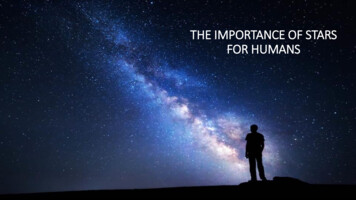
Transcription
THE IMPORTANCE OF STARSFOR HUMANS
THE STARSThe reason why stars are so important is because they havehelped humans navigate through Earth . When it was dark thesestars would light up the sky giving people light . In addition starsare very important because they make life on Earth. the mostimportant is the Sun, because without that it wouldn't be life onEarth . Earth would just be a rock with ice.
Stars since ancient times are discribed as forever, hope,destiny, heaven and freedom.They have also for us people great importance and we believethat falling stars make our wishes.For example:Ancient sailors used the stars to help guide them while theywere at sea. Just like Phoenicians looked to the sun’smovement across the heaven to tell them their direction.
THE IMPORTANCE OF SUNLife as we know would not be possible without the heat andlight of the sun.The infrared light of the sun give us the warmth we need tolive.The exposition to sunlight ultraviolet radiations also help us toform vitamin-D in our bodies. This vitamin helps us to buildteeths, bones and helps the body to absorb calcium.Also the solar energy offers clean power withdifferent benefits like: Important for the protection of the environment Prevents destruction of habitats Combats climate change Social and economic benefits
THE POLE STARThe Pole Star, or Polaris, is directly above Earth's North Pole.A pole star is lined up whit earths axis, because of it's positionover the North Pole, it's the only star that doesn't move so it’simportant for the orientation.The name Polaris, introduced in the 18th century, is shortenedfrom New Latin stella polaris, meaning "pole star".
THE STARS IN RELIGIONStar of BethlehemThe Star of Bethlehem, or Christmas Star, appears only in the nativitystory of the Gospel of Matthew, where "wise men from the East" (Magi)are inspired by the star to travel to Jerusalem.Many Christians believe the star was a miraculous sign to mark the birthof the Christ.The first use for Constellations was probably religious. People thoughtthat the Gods lived in the heavens and that they created them. Manycultures believed that the positions of the stars were their God's way oftelling stories. So it seemed natural to recognize patterns in the sky, givethem names, and tell stories about them.
As early as 5,000 years ago, some ofthe first astronomers observedchanges in the sun and moon. Theynoticed patterns in the sun's risingand setting and in the shape andposition of the moon on any givenevening.Humanity was not only inspired bythe beauty of the sky, but followedthe changes in the sky over theages and guided the sky for itsactivities such as agriculture andshipping. In addition to beinginspired by its poetic beauty, thesky continues to serve as a guide tomankind today.
People named the constellations.Most of the names are still in usetoday Stories are being told aboutthe heroes and the gods, the animalsand the mythological creaturesrepresented in the stars,in order to preserve cultures andinstill moral values into thetribesmen.
The relation between stars and art.STARRY NIGHT, oil painting madeby Vincent van Gogh.COSTELLATIONS by Mirò.STARRY DOME,Cappella degli Scrovegni, Padova
The Pole Star, or Polaris, is directly above Earth's North Pole. A pole star is lined up whit earths axis, because of it's position over the North Pole, it's the only star that doesn't move so it's important for the orientation. The name Polaris, introduced in the 18th century, is shortened from New Latin stella polaris, meaning "pole star".











